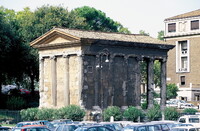| dc.coverage.spatial | Site: Rome, Lazio, Italy | en_US |
| dc.coverage.temporal | ca. 100 BCE (creation) | en_US |
| dc.creator | unknown (Ancient Roman) | en_US |
| dc.date | -100 | en_US |
| dc.date.accessioned | 2013-02-25T17:53:52Z | |
| dc.date.available | 2013-02-25T17:53:52Z | |
| dc.date.issued | -100 | en_US |
| dc.identifier | 196174 | en_US |
| dc.identifier.other | archrefid: 1547 | en_US |
| dc.identifier.uri | http://hdl.handle.net/1721.3/103682 | |
| dc.description | General view, from the southeast; The Romans rapidly adapted the Greek style to their own requirements, so that a new type of temple soon appeared, with an Italic layout and Hellenistic influence confined to architectural details. Thus the Temple of Portunus in the Forum Boarium (late 2nd century BC), despite its elegant Ionic columns, has a traditional Italic plan, with a high podium broken at the front by stairs leading up to a deep porch of six columns. [Like the Maison Carrée in Nîmes, it has a pronaos portico of four Ionic columns across and two columns deep. The columns of the portico are free-standing, while the six columns on the long sides and the four columns at the rear are engaged along the walls of the cella. This form is sometimes called pseudoperipteral, as distinct from a true peripteral temple like the Parthenon entirely surrounded by free-standing columns. It is built of tuffa and travertine with a stucco surface.] Source: Grove Art Online; http://www.oxfordartonline.com/ (accessed 7/9/2008) | en_US |
| dc.format.medium | tufa; travertine | en_US |
| dc.rights | © Scott Gilchrist, Archivision, Inc. | en_US |
| dc.subject | architectural exteriors | en_US |
| dc.subject | deities | en_US |
| dc.subject | mythology (Classical) | en_US |
| dc.subject | Greco-Roman | en_US |
| dc.subject | Late Republican | en_US |
| dc.title | Temple of Portunus | en_US |
| dc.title.alternative | Temple of Fortuna Virilis | en_US |
| dc.title.alternative | Temple of Portunus in the Forum Boarium | en_US |
| dc.type | image | en_US |
| dc.rights.access | Licensed for educational and research use by the MIT community only | en_US |
| dc.identifier.vendorcode | 1A3-R-R-TP-A1 | en_US |
| vra.culturalContext | Ancient Roman | en_US |
| vra.technique | construction (assembling) carving (processes) | en_US |
| vra.worktype | temple | en_US |
| dc.contributor.display | unknown (Ancient Roman) | en_US |


